The Equuleus constellation is quite faint and only has a few notable deep sky objects and no stars brighter than magnitude 3.00. It contains one formally named star, with the name approved by the International Astronomical Union (IAU) as Kitalpha (Alpha Equulei A).
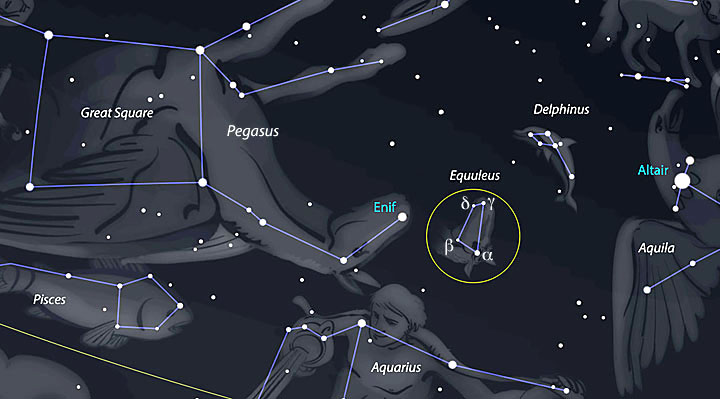
HD 200779 is the nearest star and is 48.41 light years distant from Earth. Equuleus contains three stars with known exoplanets. HD 200964 (spectral class K0IV) has two planets, while WASP-90 (F6) and HAT-P-65 (G2) have one transiting planet each.
Equuleus belongs to the Heavenly Waters constellation family, along with Carina, Columba, Delphinus, Eridanus, Piscis Austrinus, Puppis, Pyxis and Vela. It does not contain any Messier objects and there are no meteor showers associated with the constellation.
History and Mythology Of The Equuleus Constellation
The Equuleus constellation is associated with several Greek myths, most notably the Greek mythology about Hippe, the daughter of the centaur Chiron and the nymph Chariclo. It was said that Hippe was seduced by Aeolus and became pregnant, but was too ashamed to tell Chiron and hid the pregnancy from him. She fled to the mountains where she gave birth to a child named Melanippe.
Chiron eventually went looking for Hippe. She prayed to the Gods that he wouldn’t find her, but they turned her into a mare. She appears to still be hiding from Chiron, who is represented by the constellation of Centurus, with only her head showing behind Pegasus.
The creator of the Equuleus constellation is unknown, but Equuleus was introduced by the Greek astronomer Claudius Ptolemy in the 2nd century CE along with other Greek constellations.
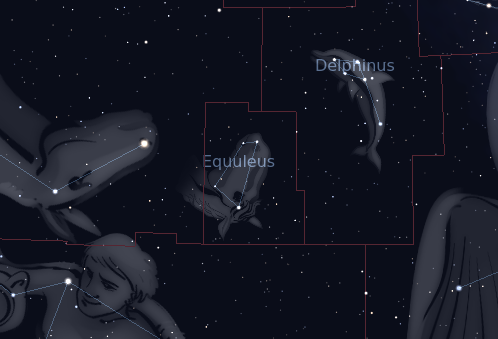
Location Of The Equuleus Constellation
As we mentioned above, the Equuleus constellation is the second smallest constellation in the night sky and occupies only 72 square degrees. It is located in the fourth quadrant of the northern hemisphere (NQ4) and can be seen at latitudes between +90° and -80°. It’s neighboring constellations are Aquarius, Delphinus and Pegasus.
While the Equuleus star is not too difficult to find with the naked eye, it can be more difficult to find in light polluted areas because it is so faint. It lies between Enif, the brightest star in Pegasus, and Altair, the luminary of Aquila, near the distinctive diamond-shape of Delphinus.
Notable Stars
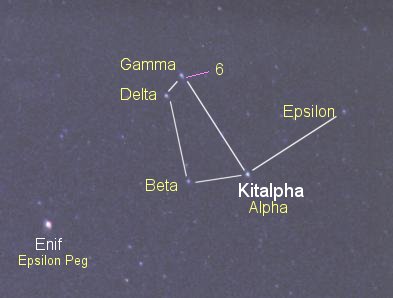
Kitalpha
Kitalpha, also known as Alpha Equulei, is a spectroscopic binary star composed of a yellow giant of the spectral type G7III and a chemical peculiar white main sequence star with the stellar classification kA3hA4mA9. It is the brightest light in Equuleus. It has a magnitude of 3.919 and is roughly 190 light years away from us.
Kitalpha has a mass equal to 2.3 times the Sun and a radius of 9.2 times the Sun. It’s surface temperature is 5,100 K and is 52.5 times more luminous than the Sun. It is thought to be around 740 million years old.
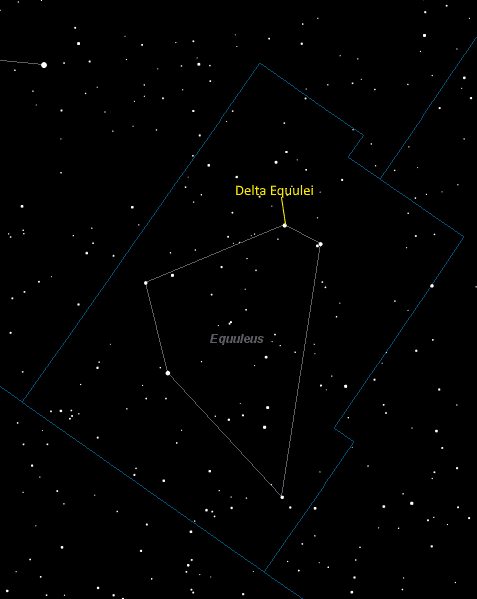
Delta Equulei
Delta Equulei is the second brightest star in Equuleus and has a visual magnitude of 4.47. It is located around 59.4 light years from Earth and both of it’s components have the stellar classification F7V, indicating white main sequence stars.
It is thought to be around 3 billion years old. Delta Equulei has a mass of 1.192 times the Sun and a radius of 1.30 times the Sun.
Gamma Equulei
Gamma Equulei is around 118 light years from Earth and has a magnitude that varies from 4.58 to 4.77. It is a double star and is classified as a rapidly oscillating Ap (roAp) star, meaning that it shows short period variations in brightness. It exhibits pulsations with periods of about 12 minutes.
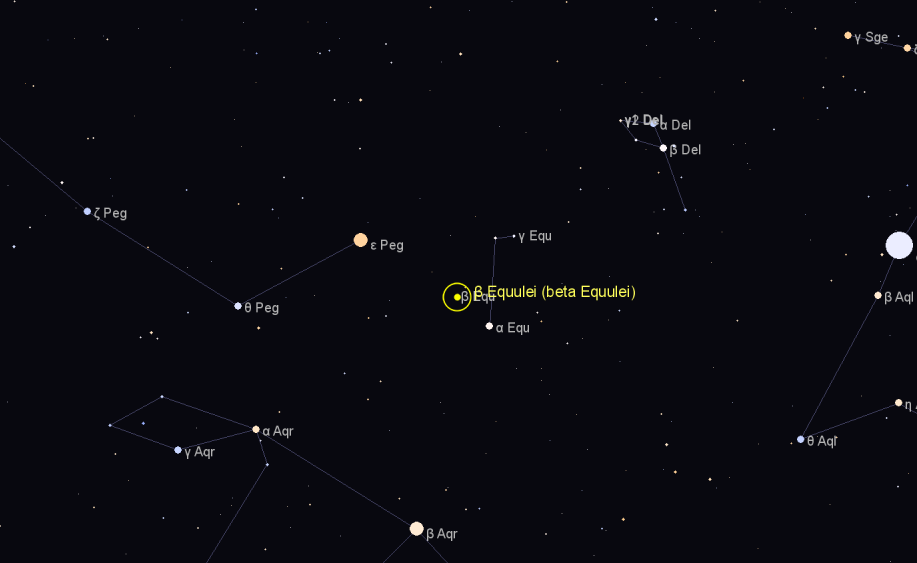
Beta Equulei
Beta Equulei is a white main sequence star of the spectral type A3V and is estimated to be 600 million years old. It is around 133 light years away from us and has an apparent magnitude of 5.19. It is 4.02 times larger than the Sun and 78.3 times brighter. While it has four visual companions, it is not associated with any of them.
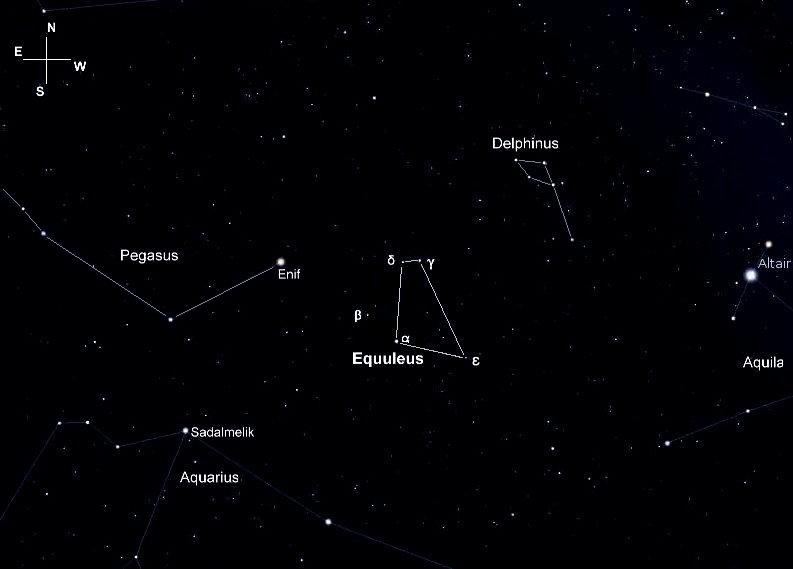
Epsilon Equulei
Epsilon Equulei has four components with a combined visual magnitude of 5.23. It lies around 180 light years from the Sun and is thought to be around 1.5 billion years old. The first two components of the star — Epsilon Equulei A and B — are both class F main sequence stars slightly more massive than the Sun, with component A having a 1.74 solar mass and component B having a 1.53 solar mass. They have apparent magnitudes of 5.96 and 6.31 respectively, and they orbit each other with a period of 101.5 years.
Epsilon Equulei C is the fourth component and is considerably fainter than the main two. It is separated by about 10 arcseconds from the main pair and has an apparent magnitude of 7.35.
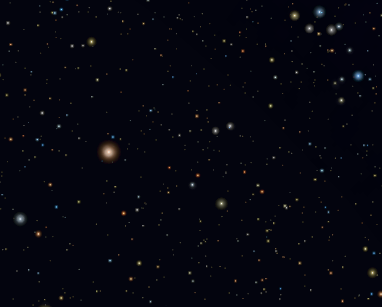
Zeta Equulei
Zeta Equulei is a single star and an orange giant of the spectral type K5III. It is located around 770 light years from Earth and has a visual magnitude of 5.593. It has a radius of 63 times the Sun and has a surface temperature of 3,893 K, meaning it is 949 times more luminous than the Sun.
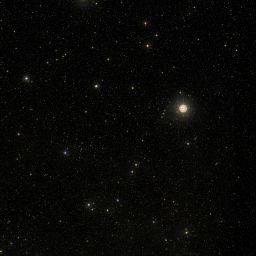
Lambda Equulei
Lambda Equulei is too faint to be visible to the naked eye. It is a binary star with a combined apparent magnitude of 6.698 and lies 260 light years away from us. Lambda Equulei A is the primary component and is a main sequence star of the spectral type F6V. It has a visual magnitude of 7.41, with a mass of 1.73 solar masses and a radius that is 3.37 times that of the Sun. It has a surface temperature of 6,561 K and is thought to be 1.6 billion years old.
Lambda Equulei B is fainter than Lambda Equulei A and has a magnitude of 7.64. It has a radius 2.74 times that of the Sun. It shines with with 10.828 solar luminosities.
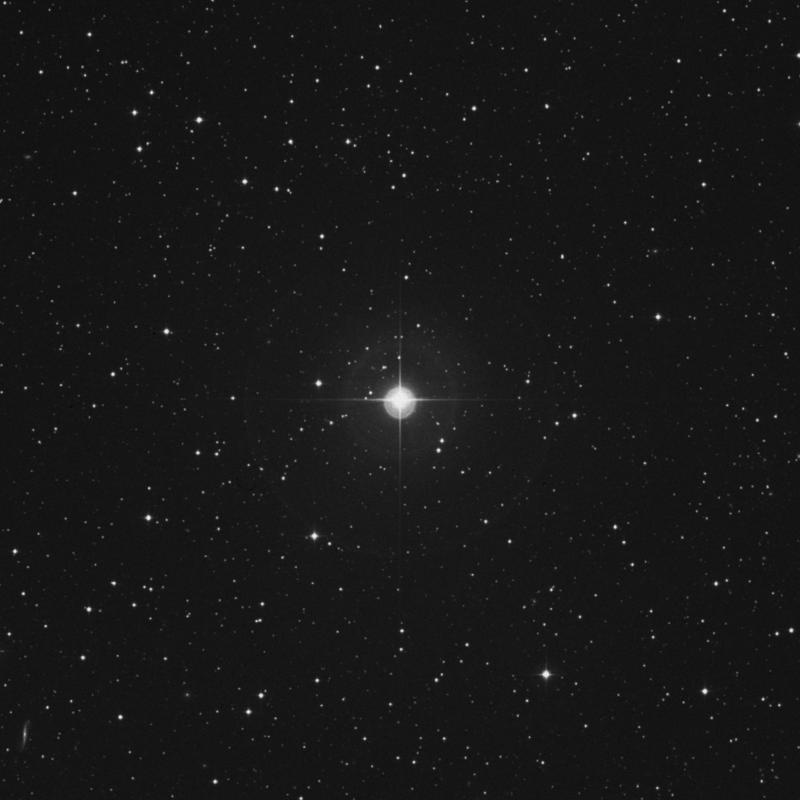
9 Equulei
9 Equulei has the stellar classification M2IIIa and is a red giant on the asymptotic giant branch. It is located around 740 light years away from us and has an apparent magnitude of 5.798. It is 58 times larger and 720 times brighter than the Sun.
4 Equulei
4 Equulei is a binary star consisting of a white main sequence star of the spectral type F8V as the primary star. It is located at around 160 light years away from Earth and has an apparent magnitude of 5.94, making it visible to the naked eye but only in very good conditions.
It has a mass of around 1.39 times that of the Sun, and a radius of around 1.2 times that of the Sun. 4 Equulei is also 4.98 times more luminous than the Sun with a temperature of 6,213 K. It is thought to be 3.07 billion years old.
6 Equulei
6 Equulei is thought to be the primary component in an astrometric binary system, where the companion is not visible. It is a white main sequence star of the spectral type A2Vs. 6 Equulei is located around 380 light years away from us and has an apparent magnitude of 6.07.
It has a mass that is 2.59 times that of the Sun and a radius that is 1.7 times that of the Sun. This star has a temperature of 9,078 K which makes it 70.6 times more luminous than the Sun. It is thought to be 970 million years old.
HD 199942
HD 199942 is a double star that lies around 184 light years away from Earth. It has a combined apparent magnitude of 5.98 and has the stellar classification F1Vp, indicating that the main component is a chemically peculiar white main sequence star.
The main component is thought to be 1.016 billion years old. It has a mass of 1.65 times that of the Sun and a radius 1.97 times that of the Sun. It is 10.2 times more luminous than the Sun and has an apparent magnitude of 6.23. The companion star is thought to be much fainter, with a visual magnitude of 8.13.
HD 200964
HD 200964 is an orange subgiant star of the spectral type K0 IV that is located around 237.3 light years from the Sun. It has a visual magnitude of 6.64, a mass of 1.45 times that of the Sun and a radius of 4.92 times that of the Sun. It is thought to be 3.3 billion years old.
In July 2010, it was discovered that two large extrasolar planets were orbiting HD 200964. The inner planet orbits at a distance of 1,601 astronomical units and the outer one at 1,950 astronomical units. The closer planet has a mass almost double the mass of Jupiter. In 2019, it was reported that a third planet had also been found to be orbiting HD 200964, but this has yet to be confirmed.
Deep Sky Objects
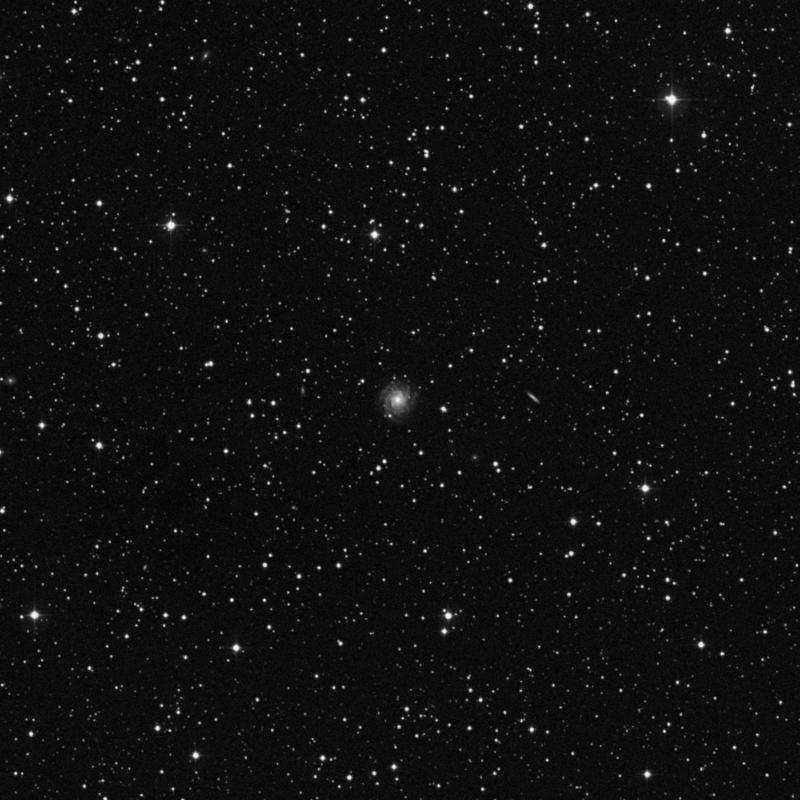
NGC 7015
NGC 7015 is a spiral galaxy. It has a size of 1.9 x 1.6′ and a visual magnitude of 13.25. It is around 203.2 million light years away from Earth. This galaxy was first discovered by French astronomer Édouard Stephan in 1878.
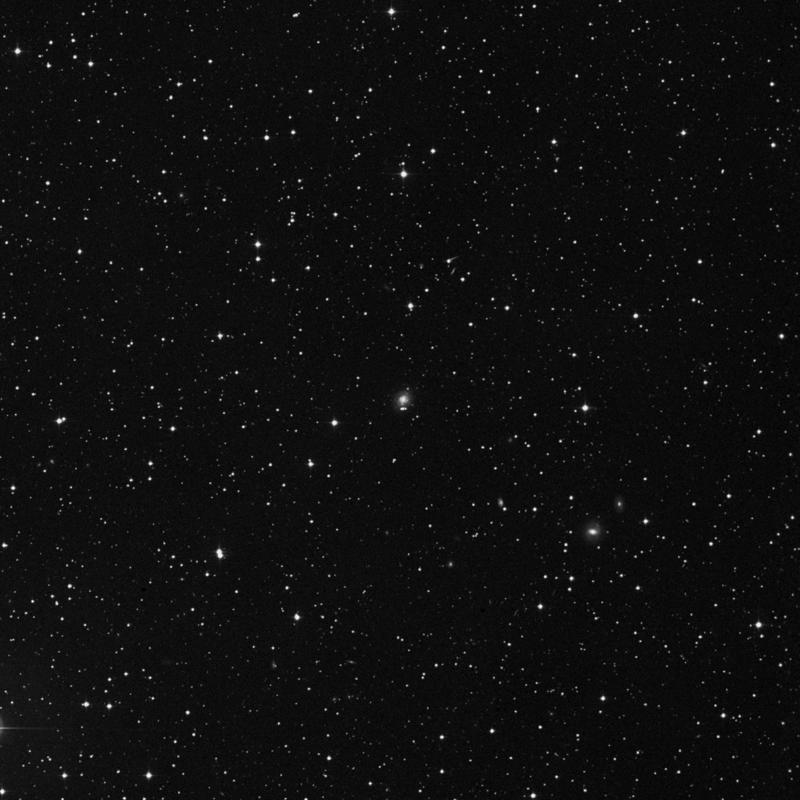
NGC 7040
NGC 7040 is also a spiral galaxy. It was first discovered by American astronomer Mark Harrington in 1882. It has an apparent magnitude of 14.9 and lies 257.5 million light years away from us.
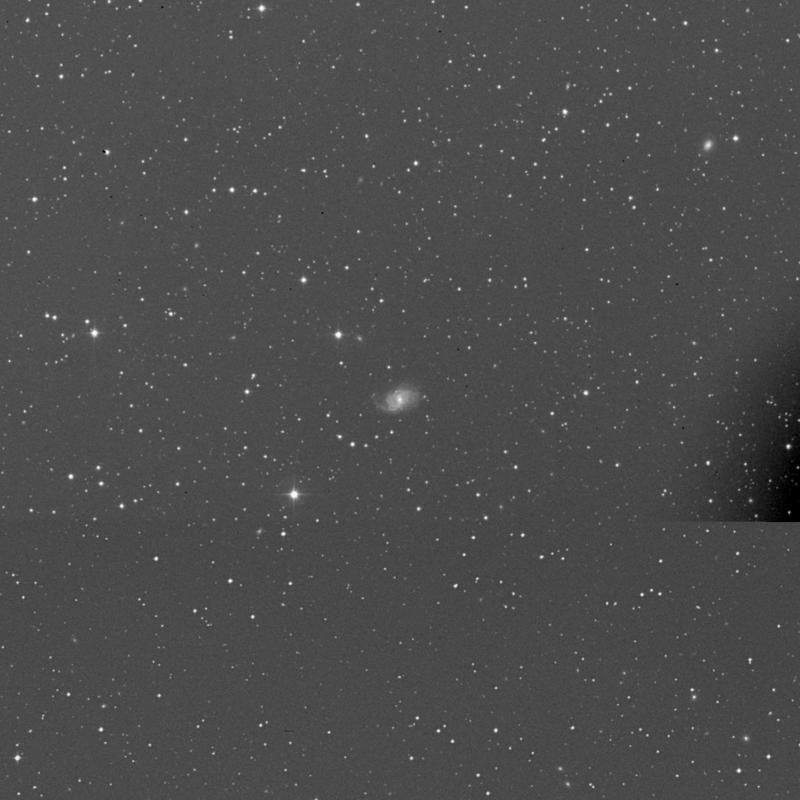
NGC 7046
NGC 7046 is a barred spiral galaxy. It has an apparent size of 1.9 x 1.3′ and 176 million light years away from Earth. It has an apparent magnitude of 13.75 and was discovered by William Herschel in October 1790.
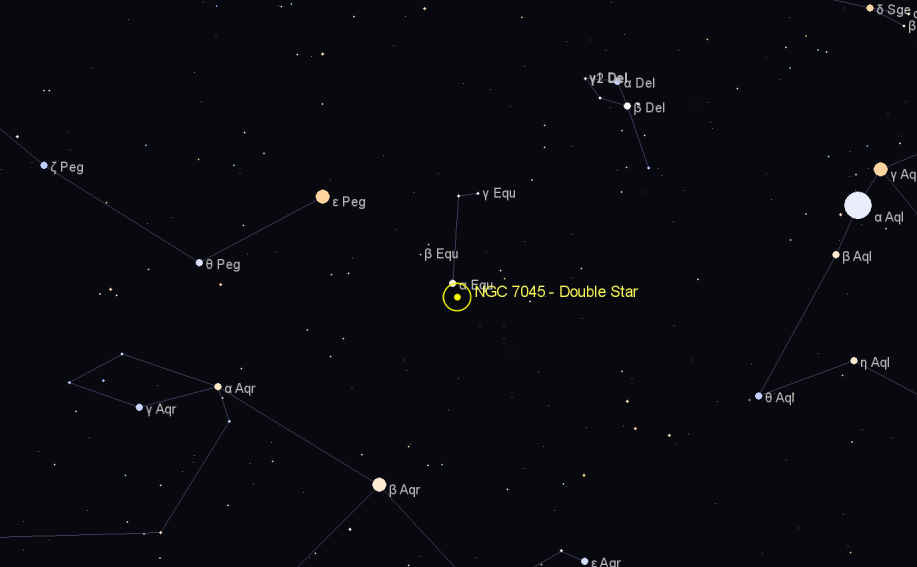
NGC 7045
NGC 7045 is not technically a deep sky object, but actually a binary star in Equuleus with a visual magnitude of 12.0. It was discovered by John Herschel in July 1827 and included on the list of NGC objects.
Images:
- Equuleus 1 – https://www.universetoday.com/20711/equuleus-constellation/
- Kitalpha – http://stars.astro.illinois.edu/sow/equ-t.html
- Delta Equulei – https://www.universeguide.com/star/104858/deltaequulei
- Epsilon Equulei – https://bestdoubles.wordpress.com/2011/09/04/horsing-around-in-equuleus-one-more-time-beta-β-and-epsilon-ε-equulei-s-781-and-σ2737-delphinus/
- Zeta Equulei – https://www.constellation-guide.com/constellation-list/equuleus-constellation/
- Lambda Equulei – http://informationaboutstars.com/starinfo.dc/star/id-259000/
- NGC 7015 – https://theskylive.com/sky/deepsky/ngc7015-object
- NGC 7040 – https://theskylive.com/sky/deepsky/ngc7040-object
- 9 Equulei – https://theskylive.com/sky/stars/9-equulei-star
- NGC 7046 – https://theskylive.com/sky/deepsky/ngc7046-object
- Location of Equuleus – https://in-the-sky.org/data/constellation.php?id=36
- Some Images created with the NightVision app – https://www.nvastro.com/nvj.html
- Some Images created with the Stelvision Sky Map https://www.stelvision.com/en/sky-map/